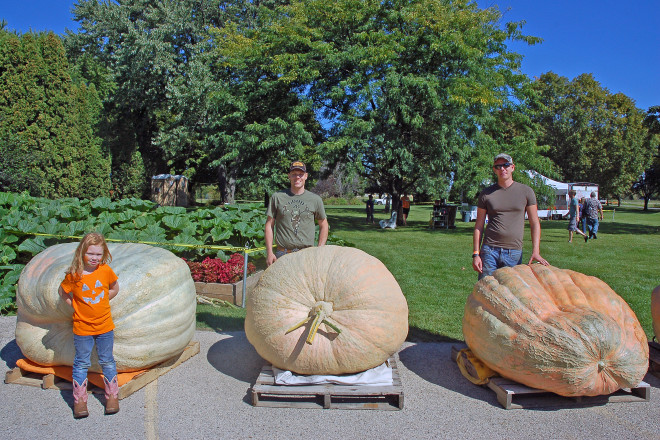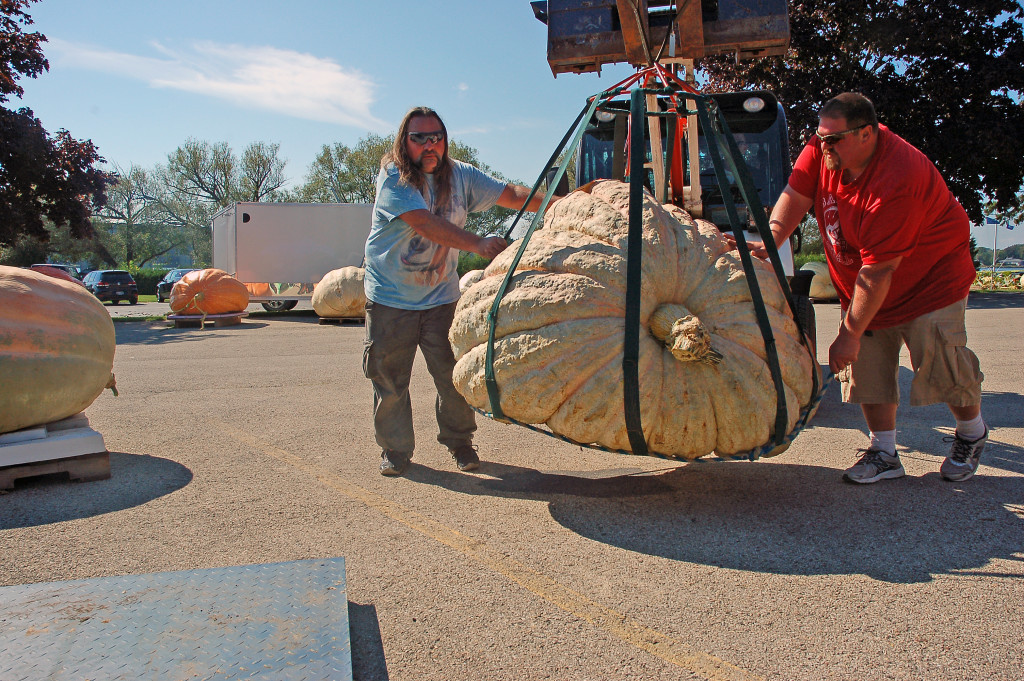In Search of Great Pumpkins
- Share
- Tweet
- Pin
- Share

It’s hard not to feel a little sorry for Linus, standing alone with his blue blanket, silhouetted by the full moon, hoping his pumpkin patch is “sincere” enough to attract the Great Pumpkin. While Linus’ Great Pumpkin never does appear, Linus lovers everywhere can take heart. Half a century after It’s the Great Pumpkin, Charlie Brown aired, great pumpkins are rising out of pumpkin patches everywhere. And while the growers producing them do so less for spiritual reasons and more as competitive sport, the sport is a friendly one with a good amount of Linus-like sincerity.
Tanner Conway, 21, of Austin, Minn., and Josiah Brandt, 23, of Rudolph, Wis., are two friends who have been growing giant pumpkins for about eight years. They agree that it’s “addictive,” in part because the community is so supportive.
According to Conway, “Some of my best friends are growers. You won’t find better people. We’re all in it to beat our own personal best, but we pull for each other, too.”
Conway and Brandt competed in the 2nd Annual Pumpkinmania held at Leathem Smith Lodge in Sturgeon Bay in late September and had a friendly side bet. Because Brandt’s 1,965-pound entry exceeded 1,950 pounds (and, incidentally, broke the state record), Conway had to jump in Sturgeon Bay. He laughs, “Josiah ended up joining me. It was pretty refreshing.” To underscore the comradeship involved, it was Conway’s “top secret” pumpkin food that helped Brandt’s pumpkin win.
Andy Wolf of Little Valley, New York, presides over the Great Pumpkin Commonwealth, a group dedicated to cultivating the hobby of growing giant pumpkins, ensuring the quality of the fruit, the fairness of the competition and the fellowship of those participating. He estimates there are as many as 3,000 giant pumpkin growers and more than 100 officially sanctioned competitions worldwide.
“It’s really taken off. I don’t know how many grow to compete, but a lot of people are having fun doing it.” The number of giant pumpkin growers is not the only thing increasing, so is the size of the fruit they grow. In 2004, the heaviest pumpkin on record weighed 403 pounds. Today, it weighs more than a ton. The current world record at 2,323 pounds belongs to a software account manager from Switzerland.
Conway is an enthusiastic horticulture student at University of Wisconsin – River Falls. He described himself as “a little heartbroken” at Pumpkinmania, and it wasn’t because his 1,170-pound specimen was disqualified for “structural damage,” aka soft spots. “It’s because this might be my last growing season for a while. I’ve got to get an internship. My parents want me to get a good one even if it’s far away, but I just want to grow pumpkins. I’m hoping to get one close to my pumpkin patch. It gets in your blood.”

Todd Ehlenbecker and Jeremiah Plansky maneuver a giant pumpkin to the scale. It weighed in at 1,178 pounds. Photo by Jim Lundstrom.
Brandt, a paper mill worker and welder agrees. “It is addictive and it takes a lot of time, but it’s enjoyable. I like to grow for two years and then take a year off.” It’s not unusual for growers to invest 30 hours a week in the hobby and many admit that it becomes a personal and a family obsession. Part of the thrill is the fact that when giant pumpkins are in full growing mode, you can almost see them expand; some claim they can literally hear them grow. A potential award-winner might add 50 or 60 pounds of flesh a day.
Because it’s not practical to weigh gargantuan pumpkins daily, growers use an estimating method called the OTT (Over the Top). The Over the Top computation (which may, in fact, describe more than the measuring method) uses the circumference, BS (blossom to stem) and the SS (side to side) measurements taken with a cloth tape measure so as not to wound the fruit’s flesh. When it’s time to haul giant pumpkins to a weigh-off, growers build elaborate tripods and enlist forklifts to move them.
While Linus’ efforts centered on faith and sincerity, growers today count on hard work, science and a little luck. Many of them engage in “citizen science” and keep meticulous records of their experiments.
Most of the award-winning pumpkins grown in the United States are grown in backyard patches in the Great Pumpkin Belt, an area that stretches from Washington State to Nova Scotia and can be counted on to deliver 90 to 120 frost-free days each year and winters harsh enough to kill damaging diseases.
Competitive growers typically begin with pedigreed seeds that may be purchased at seed auctions. One seed from the 2010 world record-holder brought in $1,600. One of the reasons the seeds are so valuable is that giant pumpkins produce so few; the $1,600 seed was one of only 26. Brandt explains that selling seeds other than at auction is “frowned upon” in the pumpkin-growing community. “The auctions support the local clubs and promote the hobby.” They also raise funds for the prize money, which can be significant. Brandt’s state champion earned him $3,500.
Serious giant pumpkin growers typically plant their seeds indoors in early spring and transplant them when outdoor soil conditions are right. As blossoms appear, they select the ones on the strongest vines. (A tip given to neophytes is to choose the vine before the pumpkin.) The growers then carefully hand-pollinate each female flower using the pollen of 3 to 5 male flowers. This is done at the crack of dawn to ward against bee contamination. Once pollinated, a flower is tied off, or sealed, with a piece of cloth to protect the purity of the pedigree. All award-winners are listed with the Mother (seed) and Father (pollen) identified.
As giant pumpkins begin to develop, growers turn the orbs daily so they remain perpendicular to the vine. They then prune peripheral, nutrient-sucking vines and some growers spread sand under the fruit to minimize the risk of stretch marks. At night, the pumpkins are covered with blankets that are removed again at sunrise to maximize photosynthesis.

Five-year-old Hannah Akkerman gets a round of applause from fellow giant pumpkin growers for her disqualified 1,311-pound entry. Photo by Jim Lundstrom.
And then there’s the daily feeding and watering. Serious growers “juice” their pumpkins, saturating the soil with nutrient-rich “brews” or “teas” of worm castings, molasses, liquid kelp and other secret ingredients. Conway, who’s hoping to market his secret concoction next year, explains that every mix is unique. “You find what works best for you. We all like our coffee our own way.”
In addition to good food, giant pumpkins need lots of water. (Water conservationists, plug your ears.) A New York Times article, “The Race to Grow the One-Ton Pumpkin,” sites one “extreme gardener” who used 27,000 gallons of water a month for his crop, almost enough to supply the average family of four for a year.
As autumn approaches, competitive growers are strategic in deciding what pumpkin to enter into local or regional competitions. Take a pumpkin off the vine too early and you lose crucial pounds; wait too long and you risk rot or, more dramatically, an explosion. Conway says there’s nothing worse than hearing the loud “thwack” caused by too rapid growth. “When you’re out working in your field and you hear them crack, it gives you a small heart attack. You run around lifting sheets hoping to God it’s not your biggest. That’s a double ouch.”
Although giant pumpkins are pale and misshapen versions of their smaller cousins, there’s something attractive about their solidity, the way an elderly person who’s comfortable with his or her own girth, is appealing. For all their warts and wattles, the only things that disqualify giant pumpkins from competition are soft spots, holes or signs of “caulking,” a term that refers to cheating via the injection of added water weight.
According to Brandt, “Rot is the main concern. You’re allowed to cut out a soft spot, but you might lose 8 – 10 pounds doing it. Also, the scar’s got to have time to dry before you take it to be weighed, and that can take a week.” Most growers choose one pumpkin and keep a few promising specimens on the vine, carefully assessing the possibility of taking them to other weigh-offs held later in the season.
Conway can’t exactly explain the fascination he has for giant pumpkins, but knows he’s found his calling. “This has been my passion since childhood. You put that seed in the ground and wait. Pretty soon you’ll see a difference every morning. Once that happens, you never want to grow anything else.”
